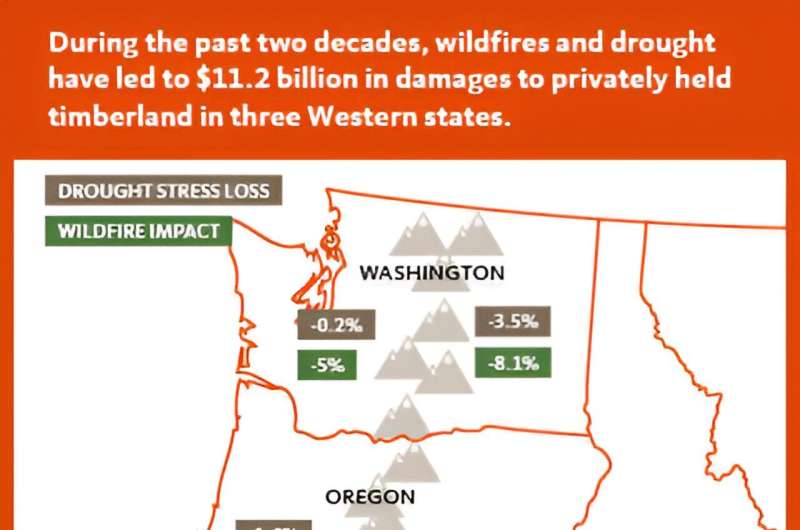This article has been reviewed according to Science X's editorial process and policies. Editors have highlighted the following attributes while ensuring the content's credibility:
fact-checked
trusted source
proofread
Wildfire, drought cause $11.2 billion in damage to private timberland in three Pacific states, study finds

Wildfires and drought have led to $11.2 billion in damages to privately held timberland in California, Oregon and Washington over the past two decades, a new Oregon State University study found.
That represents about a 10% reduction in the value of private timberland in the three states. Based on recent climate change attribution studies by other scientists, the authors of the study attribute about half of the economic damages to climate change.
While past research has estimated impacts of climate change on the value of forests in the future, researchers were interested in how climate change has already affected the value of forests in the new study.
"This study shows that climate change is already reducing the value of western forests," said David Lewis, a natural resource economist at Oregon State. "This isn't a hypothetical future effect. These are damages that have already happened because it is riskier to hold assets like timberland."
The study, published in the Journal of Environmental Economics and Management, is being released shortly after the White House announced plans to develop a national strategy to estimate the impacts of climate change on the value of the nation's natural capital, such as forests, minerals, oceans and rivers.
For the study, Lewis and postdoctoral scholar Yuhan Wang, who led the work, analyzed a dataset of just over 9,000 sales of privately-owned timberland that were a minimum of 10 acres from 2004 to 2020 in California, Oregon and Washington.
They then linked the transactions with data on small and large wildfires along with data on drought stress accessed by a measure known as vapor pressure deficit.
They found that across the three states the recent increases in drought stress have already reduced the economic value of timberland by 1% on average while increases in large wildfires have reduced timberland values by an additional 8.7% over the past two decades.
The research also showed that the bulk of large wildfire-induced losses (nearly 7.4% of the 8.7%) were not due to direct burning of private timberland, but instead related to increasingly frequent neighboring fires that have altered landowners' expectations of fire arrival and increased risk of investing in private timberland, the authors say.
"The bulk of the damage is from altered risk expectations in land markets—not direct damage to the existing tree stock on the stand," Wang said. "That is a key and somewhat surprising finding."
In the three-state study region, about one-third of all forests are privately owned, with the remainder owned by federal, state and local governments, the authors note. However, most of the timber harvested—and almost all the timberland bought and sold—is privately held.
The researchers broke down the findings by state and also by east and west of the Cascades in Oregon and Washington. Findings include:
- In California, drought stress accounted for a .2% gain in timberland value and a 13.7% decrease due to large wildfires. The drought stress gain is in part a result of most of the private timberland being concentrated in the wetter northwestern region of the state.
- In Oregon west of the Cascades, drought stress losses were 1.6%, and large wildfire losses were 7.7%. East of the Cascades, drought stress dropped to 1.1%, and large wildfire loss declined to 6%. The difference between east and west of the Cascades in Oregon is in large part because there is more private timberland west of the Cascades that has been in close proximity to large wildfires in recent years.
- In Washington, west of the Cascades, drought stress led to a .2% loss in timberland value, and large wildfire caused a 5% decrease in timberland value. East of the Cascades, the losses were 3.5% due to drought stress and 8.1% because of large wildfires.
The authors note that the findings have several policy implications. They show that climate change can alter the value of natural capital, in this case private timberland, and impact private investments and potentially require public intervention to prevent management changes.
Also, the findings provide new insights into estimating wildfire damages, beyond property losses, health care costs, injuries, fire suppression costs and air and water quality damages.
"The study helps us understand the effects of historical climate shocks on the economic value of natural capital and also provides insights into the potential benefits of actions to mitigate extreme weather events," Wang said.
More information: Yuhan Wang et al, Wildfires and climate change have lowered the economic value of western U.S. forests by altering risk expectations, Journal of Environmental Economics and Management (2023). DOI: 10.1016/j.jeem.2023.102894
Provided by Oregon State University





















